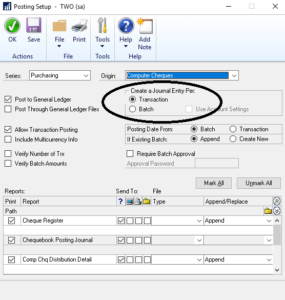Matching Up General Ledger Information with Subledger Information through Smartlist in Dynamics GP
As part of a month end or year end reconciliation process, many users have lamented the difficulty in finding that “needle in a haystack” General Ledger transaction for their Accounts Payable cheque, Accounts Receivable invoice, or other subledger transactions.
They do not know that these two sets of data is already being matched up, and viewable through an existing, out of the box Smartlist.
As it turns out, each and every General Ledger transaction has various pieces of information relating to the subledger transaction that it originated from. For example, General Ledger transactions originating from Accounts Payable cheques will automatically have vendor information, and cheque number information, among other items.
Having said that, there is a requirement. Without the proper setting, the Smartlist won’t track the subledger information. Here’s that requirement:
REQUIREMENT
Tools – Setup – Posting – Posting

On the right side, you need to have “Create a Journal Entry Per” set to “Transaction”. Without that, a General Ledger transaction could be referring to any number of subledger transactions. Although that is OK, for the purpose of relating that to the Smartlist in this blog entry, that won’t do.
Keep in mind that if you decide to change this setting, it is on a go forward basis. Prior General Ledger transactions won’t change.
How to Get the Smartlist Set Up
Now that the requirement is out of the way, we can concentrate on how to get the Smartlist set up.
As it turns out, this is a Smartlist everyone already knows and loves. The Account Transactions Smartlist will give you everything you want. The problem is simply that most people don’t know all the available options.
Open up Smartlist, then expand the “Financial” folder, and go to the “Account Transactions” Smartlist
Some favourite columns are:
- Originating Document Number (such as AP document/invoice number, AR document number)
- Originating Master ID (could be vendor ID, customer ID, inventory item ID, and more)
- Originating Master Name (could be vendor name, customer name, etc.)
- Originating Control Number (could be AP Voucher number,)
- Originating Company ID (perfect for Intercompany Transactions)
- … and more
Below is an example of what you end up with.

Enjoy your next month end reconciliation!